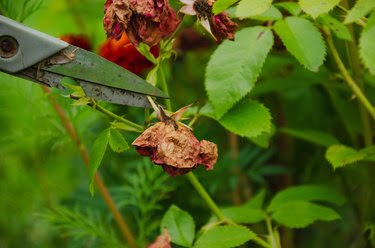Quck answer
If your rose bush is dying, there are steps you can take to save it. First, check if it’s still alive by scratching the bark. If it’s green underneath, there’s hope. Prune away any dead or diseased wood, making clean cuts. Water the bush deeply and regularly, ensuring the soil is well-drained. Provide adequate sunlight and fertilize with a balanced rose food. Mulch around the base to retain moisture. Monitor for pests and diseases, treating as necessary. With proper care and attention, your dying rose bush may recover and thrive once again.
Rose bushes (Rosa spp.) hold a special place in any flower garden, but they also come with their fair share of issues. This may leave you seeking ways to restore a dying rose bush in order to keep the fragrant blossoms and beautiful green foliage thriving. Examining the cause of the rose bush problems can help you address the issue before the bush perishes completely. Common problems that can endanger your rose bushes include improper cultivation practices, pests, and diseases. Even if your rose bush appears lifeless, there is still hope. In most climates, rose plants enter dormancy during the winter, and they often appear quite dead by the time spring arrives. Even if all of a rose’s stems, or canes, appear dry and black, we have tips on how to determine if a rose is still alive.
How to Revive a Dying Rose Bush

Image Credit:
Kyaw_Thiha/iStock/GettyImages
Your rose bush may be in poor health due to unfavorable soil conditions, improper watering, diseases, or pests. Carefully examine the bush and its surroundings, and then follow these steps to help rejuvenate your rose.
A struggling rose bush may be dying due to unsuitable growing conditions. When growing roses, the ideal location should receive at least six hours of sunlight each day, have ample space for their roots, and provide good air circulation. Morning sunlight is preferable as it is less intense than afternoon light, and it aids in drying the rose bush foliage early in the day, reducing the risk of many fungal diseases that thrive in moist conditions.
1. Ensure Sufficient Space
If your rose needs more sunlight and breathing room, trim or relocate surrounding plants. Moving nearby plants may require uprooting them and transferring them to a different area of the garden to allow more sunlight and improve air circulation around your roses. If surrounding plants are significantly larger than your roses, you may want to consider digging up and moving your roses to a more suitable location. If you have planted roses as foundation plants against an exterior wall, steps, or other structure, keep in mind that these structures hinder air circulation around your roses. While certain types of roses are suitable as foundation plants, not all of them are, especially those that are more susceptible to fungal diseases like powdery mildew.
2. Provide Winter Protection
If winter temperatures frequently drop below 20 degrees and your rose bush is situated in an exposed area, provide additional protection when the next winter arrives. After the first hard frost, trim back any excessively long canes and pile 10 to 12 inches of loose, well-draining soil, leaves, or straw around the plant. You can also tie long canes together instead of pruning them to prevent them from breaking during winter winds.
3. Ensure Well-Drained Soil
Loose, loamy, nutrient-rich soil is ideal for a rose garden. Compact or heavy clay soil can impede root growth and lead to waterlogged soil, which often results in root rot that can kill your rose bushes.
If your rose bushes are planted in poorly draining soil:
- To improve drainage, try sloping the area around the rose bushes.
- Next, add 2 or 3 inches of well-rotted manure, compost, leaf mold, or a combination of organic matter around the bushes.
By applying organic matter annually, the soil will gradually improve. If the rose bush is small enough, consider relocating it to a more suitable spot or dig it up to improve the soil. Mix 1/4 peat moss, compost, or other organic matter with 3/4 native soil and amend the entire planting site, not just the planting hole. Transplanting roses in early spring, before they fully wake up from dormancy, usually leads to higher success rates compared to transplanting in hot weather, which further stresses the plants.
4. Ensure Proper Watering and Mulching
If you have neglected your rose bush care, focus on providing all the necessary care for the roses to thrive. When there is no rain, water your roses twice a week during hot summer weather, making sure to soak the root zone for deep watering. Apply several inches of mulch around the bushes to retain moisture between waterings, but keep the mulch at least 6 inches away from the canes in all directions. Frequent shallow watering can cause the roses to dry out and encourage shallow root growth, which can lead to heat damage to the roots. Your roses need consistent moisture, but overwatering can increase the risk of diseases and root damage.
5. Regularly Prune
Regular pruning of roses can also contribute to their overall health. Late winter to early spring is the best time for pruning most types of roses. Remove damaged, diseased, or infested rose branches as soon as you notice them to prevent further spread and damage. Always sanitize your pruners with alcohol between cuts to prevent disease transmission.
6. Watch Out for Pests
Aphids, Japanese beetles, spider mites, thrips, and rose midges are common pests that can harm rose bushes. These pests are often visible on the plants, especially during a major infestation. You may also notice holes or distortion in the leaves and flowers where the insects feed or suck sap.
Many rose pests can be removed from the branches by spraying them with a steady stream of water from a garden hose. Japanese beetles can be manually removed from the foliage and placed in a container of soapy water. If possible, avoid using synthetic chemical pesticides, as they can also harm beneficial insects that help control rose pests. Insecticidal soap is a safer option for killing many rose pests, including aphids, mites, and thrips, while still being safe for most beneficial insects when used according to the instructions on the label.
7. Check for Rose Bush Diseases
Rose diseases can also affect the leaves and blooms. Excessive moisture, particularly on foliage that doesn’t have enough time to dry before nightfall, is often the cause of many rose diseases. Pruning your bushes to allow for better air circulation and being cautious not to wet the foliage can help reduce the risk of diseases.
Black spot is a fungal disease that manifests as black spots on leaves. Eventually, the leaves turn yellow and fall off. Twisted and curled leaves with a powdery coating may indicate powdery mildew. Botrytis blight causes a gray fuzzy growth, usually on older and dying tissue like old flowers. To treat most fungal diseases, it is necessary to remove and dispose of the affected branches. Using fungicide is particularly effective in preventing common rose diseases when applied to new growth as it emerges, rather than waiting until the disease has taken hold of the plant.
There are other diseases that have no cure. Crown gall results in growths on the stem at the soil line, which can hinder the growth of the rose bush. The viral rose mosaic disease is another incurable disease that causes yellow lines on leaves and may stunt growth or weaken the plant. Rose rosette disease leads to irregular growth patterns, including excessive thorns, deformed and reddish leaves, and can cause the decline of the bush. The best approach for all these incurable diseases is to remove and destroy the affected bushes to prevent the spread of diseases to other plants.
How to Determine if a Rose Bush Is Dead

Image Credit:
Elena Glomazdo/iStock/GettyImages
If you are unsure whether your plant is dying, you are not alone. Depending on the species and cultivar, roses can be hardy in U.S. Department of Agriculture plant hardiness zones 2 to 11, and many survive winter even if certain parts die back. However, there are times when roses show no signs of life in the spring. Here are a few methods to check if your rose bush is still alive.
1. No Leaves
The easiest way to determine if a rose is alive or dead is to wait and see if it sprouts green leaves in the spring. Keep a close eye on the plant to observe if leaf buds form along the stems in late winter or early spring. If they do, you will be able to identify which parts of the plant are dead and which parts are alive. Once you notice swollen leaf buds, start pruning in the spring to remove the dead wood.
Tip
Before using your pruning tools on roses, make sure to sanitize them. Also, sanitize them after each cut and when you finish pruning. You can sanitize your tools by wiping the blades with alcohol or soaking them in alcohol.
2. No Green
If you do not want to wait for leaves to sprout or if you have not observed any signs of life in the rose bush during spring, check if any parts of the rose canes are still alive. First, remove any winter protection from the base of the plant. Starting halfway down a cane, use a sanitized pruning knife to scrape off the outer layer of bark.
If the cane is alive, you will see a green layer beneath the bark. If the cane is dead, the inner layer will be brown. If you come across a dead area, continue using the knife periodically down the cane until you find a green layer or reach the base of the plant. If you do not find any green on the canes, then the rose bush is most likely dead.
3. No Stems Above Graft Union
Some roses have the ability to revive from their roots even if the upper canes are dead. This ability is often determined by whether or not the roses are grafted. Certain rose bushes have their tops grafted onto more resilient rootstocks to enhance their hardiness. Examples of grafted roses include hybrids like Rosa ‘Hotel California’ (USDA zones 5 to 9). On the other hand, there are roses that grow on their own roots, including species roses and many old garden roses.
A grafted rose is considered dead when all the stems above the graft union, which is the central part where the canes sprout from, are dead. While the rose may still produce shoots from its roots, it will no longer be the same type of rose bush as before. Instead, it will take on the characteristics of the rose species used as its rootstock, and there is a possibility that it may not bloom at all. However, roses growing on their own roots can still regenerate from the roots. Therefore, it is advisable to wait until late spring or early summer to observe if new shoots emerge before deciding to remove these plants.


